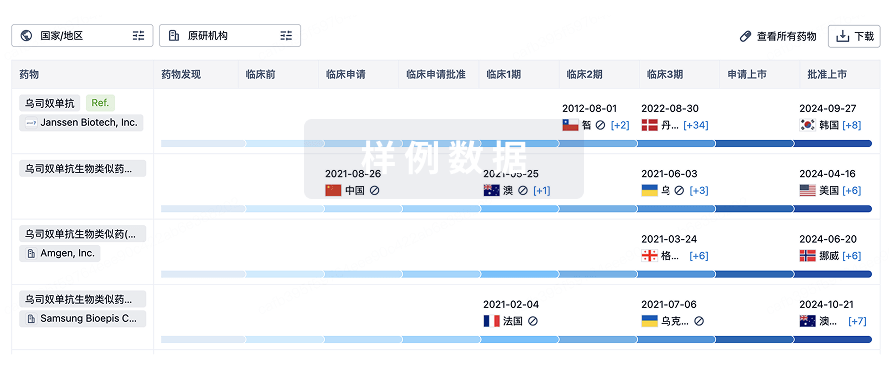预约演示
更新于:2025-08-23
YH-14617
更新于:2025-08-23
概要
基本信息
原研机构 |
在研机构- |
最高研发阶段终止临床2期 |
首次获批日期- |
最高研发阶段(中国)- |
特殊审评- |
登录后查看时间轴
关联
6
项与 YH-14617 相关的临床试验KCT0004652
A Multi-center, Randomized, Double-Blind, Placebo-Controlled Phase ?a Study to Evaluate the Efficacy and Safety of Subcutaneous SR-Exenatide (PT320) in Patients with Early Parkinson's Disease
开始日期2020-03-19 |
申办/合作机构 |
NCT04269642
Phase IIa Study to Evaluate the Efficacy and Safety of Subcutaneous SR-Exenatide (PT320) in Patients With Early Parkinson's Disease
This study is to evaluate the safety and efficacy of sustained release (SR)-Exenatide (PT320, Q1W and Q2W) in the treatment of patients with early Parkinson's disease (PD).
开始日期2020-03-19 |
申办/合作机构 |
NCT03961256
A Phase 2, Prospective, Randomized, Multicenter, Open-Label, Controlled Trial to Assess the Efficacy and Safety of Exenatide SR for the Prevention of Diabetes After Kidney Transplantation.
Researchers are trying to determine if an anti-diabetes medication, called Exenatide SR, is well tolerated in kidney transplant patients with elevated blood glucose levels, and if it's effective in preventing diabetes.
开始日期2019-05-09 |
申办/合作机构 |
100 项与 YH-14617 相关的临床结果
登录后查看更多信息
100 项与 YH-14617 相关的转化医学
登录后查看更多信息
100 项与 YH-14617 相关的专利(医药)
登录后查看更多信息
11
项与 YH-14617 相关的文献(医药)2025-06-01·PHARMACOLOGICAL RESEARCH
Glucagon-like peptide-1 receptor agonists in neurodegenerative diseases: Promises and challenges
Review
作者: Popławska-Domaszewicz, Karolina ; Tan, Eng King ; Yi, Lingxiao ; Jankovic, Joseph ; Chaudhuri, Kallol Ray ; Zhou, Zhi Dong
Glucagon-like peptide-1 (GLP-1) receptor agonists (GRA) belong to a class of compounds that reduce blood glucose and energy intake by simulating actions of endogenous incretin hormone GLP-1 after it is released by the gut following food consumption. They are used to treat type 2 diabetes mellitus (T2DM) and obesity and have systemic effects on various organs, including the brain, liver, pancreas, heart, and the gut. Patients with T2DM have a higher risk of developing neurodegenerative diseases (NDs), including Alzheimer's disease (AD), Parkinson's disease (PD), amyotrophic lateral sclerosis (ALS) and Huntington's disease (HD), accompanied by more severe motor deficits and faster disease progression, suggesting dysregulation of insulin signaling in these diseases. Experimental studies have shown that GRA have protective effects to modulate neuroinflammation, oxidative stress, mitochondrial and autophagic functions, and protein misfolding. Hence the compounds have generated enormous interest as novel therapeutic agents against NDs. To date, clinical trials have shown that three GRA, exenatide, liraglutide and lixisenatide can improve motor deficits as an add-on therapy in PD patients and liraglutide can improve cognitive function in AD patients. The neuroprotective effects of these and other GRA, such as PT320 (a sustained-released exenatide) and semaglutide, are still under investigation. The dual GLP-1/gastric inhibitory polypeptide (GIP) receptor agonists have been demonstrated to have beneficial effects in AD and PD mice models. Overall, GRA are highly promising novel drugs, but future clinical studies should identify which subsets of patients should be targeted as potential candidates for their symptomatic and/or neuroprotective benefits, investigate whether combinations with other classes of drugs can further augment their efficacy, and evaluate their long-term disease-modifying and adverse effects.
2024-09-01·NEUROBIOLOGY OF DISEASE
Corrigendum to “Pharmacokinetics and efficacy of PT302, a sustained-release Exenatide formulation, in a murine model of mild traumatic brain injury” [Neurobiology of Disease Volume 124 (2019) 439–453 /YNBDI_4338]
作者: Greig, Nigel H ; Li, Yazhou ; Kim, Dong Seok ; Hoffer, Barry J ; Rachmany, Lital ; Rubovitch, Vardit ; Tweedie, David ; Glotfelty, Elliot ; Choi, Ho-Il ; Kim, Hee Kyung ; Bader, Miaad ; Lecca, Daniela ; Pick, Chaim G
2021-04-09·ACS pharmacology & translational science
Sustained Release GLP-1 Agonist PT320 Delays Disease Progression in a Mouse Model of Parkinson’s Disease
Article
作者: Chen, Yuan-Hao ; Greig, Nigel H. ; Huang, Eagle Yi-Kung ; Lai, Li-Wen ; Wang, Vicki ; Hoffer, Barry J. ; Ma, Kuo-Hsing ; Fu, Zhao-Yang ; Choi, Hoi-II ; Olson, Lars ; Li, Yazhou ; Choi, Doo-Sup ; Chou, Yu-Ching ; Jung, Jin ; Kuo, Tung-Tai
GLP-1 agonists have become increasingly interesting as a new Parkinson's disease (PD) clinical treatment strategy. Additional preclinical studies are important to validate this approach and define the disease stage when they are most effective. We hence characterized the efficacy of PT320, a sustained release formulation of the long acting GLP-1 agonist, exenatide, in a progressive PD (MitoPark) mouse model. A clinically translatable biweekly PT320 dose was administered starting at 5 weeks of age and longitudinally evaluated to 24 weeks, and multiple behavioral/cellular parameters were measured. PT320 significantly improved spontaneous locomotor activity and rearing in MitoPark PD mice. "Motivated" behavior also improved, evaluated by accelerating rotarod performance. Behavioral improvement was correlated with enhanced cellular and molecular indices of dopamine (DA) midbrain function. Fast scan cyclic voltammetry demonstrated protection of striatal and nucleus accumbens DA release and reuptake in PT320 treated MitoPark mice. Positron emission tomography showed protection of striatal DA fibers and tyrosine hydroxylase protein expression was augmented by PT320 administration. Early PT320 treatment may hence provide an important neuroprotective therapeutic strategy in PD.
16
项与 YH-14617 相关的新闻(医药)2025-06-05
·药事纵横
2025年美国临床肿瘤学会年会(ASCO)于6月3日落下帷幕,中国药企共贡献73项口头报告,较2023年的55项继续增长,并首次有11项入选高含金量的“最新突破摘要”(LBA)。其中中国生物制药以12项口头报告创下中国企业纪录,4项为LBA,加上壁报和摘要收录,总成果超过40项。这一数量甚至超过日本,仅次于美国。恒瑞医药以79项研究入选领跑数量榜,其中4项为口头报告。而信达生物、亚盛医药、科伦博泰等企业也纷纷携重要数据亮相。中国药企在ASCO的蜕变不仅体现在数量上,十年前,中国仅有一项研究入选口头报告,如今,中国创新药已从“跟跑者”变为“定义者”,从机制创新到临床价值全面参与全球竞争。中国生物制药中国生物制药在此次 ASCO 上大放异彩,以12 项口头报告创下中国药企在 ASCO 的最高纪录,其中 4 项还被列为 “最新突破摘要”,其研究覆盖肺癌、乳腺癌、胰腺癌等多瘤种及 ADC、双抗等前沿技术领域,展现出强大的研发管线布局和创新能力。其中,备受关注的贝莫苏拜单抗联合安罗替尼(“得福组合”)在肺鳞癌一线治疗中的头对头 III 期临床研究成果。该研究对比了当前的两种主流治疗方案:帕博利珠单抗(K 药)联合化疗以及替雷利珠单抗联合化疗,结果显示,“得福组合” 组的中位无进展生存期(mPFS)达到了 10.12 个月,较对照组的 7.79 个月显著延长,疾病进展风险降低 36%,客观缓解率(ORR)也提升至 71.9%。这是全球首个在 PD-1 单抗联合化疗一线治疗鳞状非小细胞肺癌(sq-NSCLC)中取得阳性结果的 III 期研究,有望改写肺鳞癌一线治疗的临床指南,为患者提供更优的治疗选择。目前,该组合的上市申请已获中国药监局受理,其商业化前景令人期待。除了在肺癌领域的卓越表现,中国生物制药在其他瘤种也有多项研究亮相。其开展的首个针对中国人群的 CLDN18.2 ADC 药物 IBI343 联合化疗治疗胃癌和胰腺癌的研究,为消化系统肿瘤的治疗带来了新希望。此外,双抗 IBI322(PD-1×4-1BB)联合信迪利单抗治疗 RCC 和 NSCLC 的研究、双抗IBI326(CD47×CD20)治疗 RL/BTL 的研究等也有所亮相。恒瑞医药恒瑞医药作为国内医药行业的领军企业之一,在 2025 ASCO 上同样交出了一份亮眼的成绩单,恒瑞医药共有 72项研究入选,包括 4 项口头报告、5 项快速口头报告、27项壁报展示、36 项线上发表,涉及肺癌、肝癌、乳腺癌、消化道癌、妇科肿瘤、胰腺癌、肉瘤、淋巴瘤、前列腺癌等 20 多个治疗领域。在肝癌治疗领域,恒瑞医药的两项重磅研究入选口头报告。其中,P302 研究是一项多中心、开放标签、随机对照的 III 期试验,旨在评估阿得贝利单抗联合贝伐珠单抗(A+T)一线治疗肝细胞癌(HCC)的疗效和安全性。研究结果显示,阿得贝利单抗联合贝伐珠单抗组患者的中位无进展生存期(mPFS)达到了 7.7 个月,相较于索拉非尼组的 3.6 个月显著延长,刷新了当前全球晚期 HCC 免疫联合一线治疗的无进展生存期纪录。另一项 P301 研究则聚焦于阿得贝利单抗联合贝伐珠单抗(A+T)一线治疗肝细胞癌(HCC)后的维持治疗,同样取得了积极的成果,为肝癌患者的全程管理提供了新的思路和策略。恒瑞医药在ADC药物研发方面也有突出表现,集中展示了 SHR-1826(c-MET ADC)、SHR-A2102(Nectin-4 ADC)等四款 ADC 药物的临床进展,覆盖胃癌、肺癌及血液瘤领域,进一步彰显了恒瑞在 ADC 技术领域的深厚底蕴和创新能力。其中,SHR-A1811(HER2 ADC)用于晚期 HER2 突变或扩增实体瘤二线及以上治疗的新适应症上市许可申请也已获得国家药品监督管理局受理,并被纳入优先审评审批程序,有望为中国患者带来更多治疗选择。科伦博泰科伦博泰共公布了 6 款创新药的多项研究数据,其中 SKB264(TROP2 ADC)的相关研究引人关注。OptiTROP-Lung03研究显示,在既往 EGFR-TKI 治疗失败的局部晚期或转移性 EGFR 突变 NSCLC 患者中,SKB264联合化疗对比化疗显著延长中位 PFS(12.0 个月 vs4.1 个月);OptiTROP-Breast05 甠究则评估了 SKB264 联合替雷利珠单抗对比医生选择的化疗联合或不联合替雷利珠单抗一线治疗不可手术切除或转移性 PD-L1 阳性 TNBC 的疗效和安全性,联合治疗组的中位 PFS 达到 24.5 个月,而对照组仅为 12.8 个月,疾病进展和死亡风险降低了 50%。荣昌生物荣昌生物在ASCO 上公布的维迪西妥单抗(HER2 ADC)联合特瑞普利单抗及化疗 / 曲妥珠单抗一线治疗 HER2 表达胃癌的研究(摘要号 LBA4012)成为胃癌领域的一大亮点。该研究结果显示,维迪西妥单抗联合疗法在一线治疗HER2 表达胃癌患者中具有显著的抗肿瘤活性和良好的安全性,有望改变当前 HER2 阳性胃癌一线治疗的格局。此前,维迪西妥单抗已获批胃癌三线适应症,此次一线治疗数据的公布,不仅进一步拓展了其临床应用场景,也为胃癌患者带来了更多的希望和选择。亚盛医药亚盛医药的Bcl-2 选择性抑制剂 Lisaftoclax(APG-2575)联合阿扎胞苷治疗初治或维奈克拉耐药的髓系恶性肿瘤患者的研究(摘要号 7504)入选口头报告,引起广泛关注。研究结果显示,在初治的 MDS/CMML 患者中,ORR 达 64%;在既往接受过维奈克拉治疗的复发 / 难治性 AML 患者中,ORR 分别为 39% 和 50%;在对维奈克拉耐药的AML/MPAL 和 HR-MDS 患者中,ORR 分别为 17% 和 50%。该联合疗法耐受性良好,未出现新的安全信号,有望为髓系恶性肿瘤患者,尤其是维奈克拉耐药患者提供新的治疗选择,填补临床空白。2025 ASCO 年会已然成为中国创新药崛起的重要里程碑。中国药企凭借在多个瘤种和治疗领域取得的突破性研究成果,向全球展示了中国医药创新的实力和潜力。从传统的化学制药到新兴的生物制药,从单抗、双抗到 ADC 等复杂药物形式,中国药企正在不断拓展创新边界,提升研发水平,逐步走向世界舞台的中央。成绩背后也存在着一些挑战和思考,如何进一步提高临床转化效率,避免研发投入的浪费;如何在激烈的市场竞争中实现差异化发展,避免同质化内卷;如何在医保控费和出海竞争的双重压力下,实现商业价值的最大化等。这些问题需要中国药企在未来的研发和商业化过程中不断探索和解决。展望未来,随着中国药企在创新研发上的持续投入和国际化战略的稳步推进,我们有理由相信,中国创新药将在全球市场中占据更重要的地位,为全球患者带来更多希望和治愈可能。而 ASCO 等国际学术会议也将继续成为中国药企展示创新成果、与全球同行交流合作的重要平台,推动中国医药产业不断迈向新的高度。药事纵横投稿须知:稿费已上调,欢迎投稿
ASCO会议抗体药物偶联物临床结果临床3期申请上市
2024-01-08
·奇点网
*仅供医学专业人士阅读参考作为导致青壮年中枢神经系统炎症和神经退行性损伤的主要原因之一,脱髓鞘疾病的病理特征非常明显,主要是包裹中枢神经系统轴突的髓鞘或少突胶质细胞受损。脱髓鞘疾病的异质性较强,主要包括多发性硬化症(MS)和视神经脊髓炎谱系疾病(NMOSD)等。随着研究人员对疾病发病机制认知的加深,疾病修正疗法(DMT)应运而生,大幅改善了MS和NMOSD患者的预后。近年来,越来越多的DMT药物获批上市,伴随而来的是,作为需要长期治疗的疾病,在有较多药物可供选择的情况下,药物的长期疗效和安全性越来越受到重视。2023年已经在中国递交上市申请的MS治疗药物奥瑞利珠单抗(ocrelizumab)发布了长期疗效和安全性数据,而第一个在中国获批的NMOSD治疗药物萨特利珠单抗也首次发布了真实世界与长期治疗研究数据。接下来,我们就一起系统盘点一下这两个药物的长期疗效和安全性研究进展。MS研究进展MS是最常见的脱髓鞘疾病,2020年的统计数据显示,全球约有280万名患者[1]。2022年,天津医科大学总医院发布的数据显示,中国约有1.4万到7万名MS患者[2]。对于中国MS患者而言,在2018年之前干扰素β是唯一可用的DMT药物[2]。到2018年,《第一批罕见病目录》的发布[3],加快了MS的DMT药物可及性。同年,口服DMT药物特立氟胺获批上市,在随后的5年中,陆续有多个DMT药物获批上市。已获得NMPA批准上市的DMT药物除了上述药物之外,全人源化抗CD20单抗奥瑞利珠单抗的上市申请不久前获得CDE受理。2017年3月,奥瑞利珠单抗先在美国获批,随后在全球95个国家获得上市批准。目前,全球已有超过30万名MS患者接受了奥瑞利珠单抗的治疗。在2023年的第9届欧洲多发性硬化治疗与研究委员会及美国多发性硬化治疗与研究委员会联合会议(ECTRIMS-ACTRIMS 2023)上,研究人员发布了OPERA I/II和ORATORIO长达10年的长期随访数据[4]。从研究数据来看,在接受奥瑞利珠单抗持续治疗10年后,在复发型MS(RMS)患者中,近80%的患者病情没有进展,相对风险下降了23%;91.9%的RMS患者行走无需辅助,相对风险下降42%。对于原发进展型MS(PPMS)患者而言,接受奥瑞利珠单抗持续治疗10年后,超过三分之一的患者病情没有进展,相对风险下降26%;80.4%的患者不需要轮椅,相对风险降低30%。奥瑞利珠单抗治疗10年的疗效数据在长期安全性方面,研究人员分析了13个临床研究涵盖的6155名MS患者长达10年的数据[5]。总的来说,在长达10年的随访期间,奥瑞利珠单抗表现出稳定且良好的安全特征,所有RMS和进展型MS(PMS)患者的不良事件发生率保持一致。此外,在RMS和PMS群体中,无论IgG水平如何,严重感染的发生率都很低,而且随着时间的推移保持稳定。导致停药的不良事件很罕见,而且与严重感染无关。长达10年的安全性随访数据值得关注的是,考虑到MS患者中有生育能力的女性占比较多,研究人员还探索了奥瑞利珠单抗治疗对妊娠结局和新生儿的影响,相关研究结果也在ECTRIMS-ACTRIMS 2023大会上发布[5]。这项研究分析了1145例妊娠结局报告,其中512例存在宫内奥瑞利珠单抗暴露,351例没有宫内暴露,剩余282例暴露情况未知。总的来看,所有妊娠的活产率为83.6%,奥瑞利珠单抗暴露组和非暴露组分别为84.2%和88.3%。在自然流产率方面,暴露组和非暴露组分别为7.4%和9.1%;在严重先天异常方面,两组相当,分别为1.6%和1.3%,且都低于在全人群中每年2%-4%的严重先天异常出生率。奥瑞利珠单抗治疗对妊娠结局的影响不难看出,与MS患者和普通人群的流行病学数据相比,宫内奥瑞利珠单抗暴露不会增加妊娠或婴儿不良结局的风险。NMOSD研究进展从1894年报道第一个病例开始,在随后长达110年的时间里,NMOSD都被认为是MS的一个亚型[6]。直到2004年,美国梅奥诊所的研究人员在NMOSD患者血清中发现了靶向水通道蛋白4(AQP4)的特异性抗体[7],而且随后发现AQP4在经典MS患者的血液中却不存在[8]。这些里程碑式的研究成果,共同证实了NMOSD与MS是不同的独立疾病。到2007年,NMOSD的概念正式提出[9]。我国的NMOSD患病率未知,预估的NMOSD年发病率为0.278/10万,每年新发病例约为4000例[10]。目前,在全球范围内,共有三个治疗NMOSD的DMT药物,它们均在中国获批上市,分别是2021年获批的靶向IL-6R的萨特利珠单抗,2022年获批的靶向CD19的伊奈利珠单抗,以及2023年获批的靶向C5的依库珠单抗。在ECTRIMS-ACTRIMS 2023大会上,研究人员发布了萨特利珠单抗在AQP4-IgG阳性NMOSD成人患者中长达8.9年的疗效数据[11]。这个名为SAkuraMoon的研究纳入了111例NMOSD患者,其中有36例亚洲地区患者。所有患者接受萨特利珠单抗治疗的中位时间为5.9年,最长达8.9年。从研究数据来看,总体调整后的年复发率(ARR)为0.08,且不随治疗年数的增加而增加。在第288周(5.5年),72%接受萨特利珠单抗治疗的患者没有出现由独立委员会和研究者确定的首次方案定义的复发(iPDR),91%的患者没有严重iPDR,83%的患者没有临床扩展致残量表评分(EDSS)恶化。以上研究结果说明,萨特利珠单抗可以长期有效地控制住NMOSD患者的病情。萨特利珠单抗的长期疗效数据值得注意的是,来自日本[12]和美国[13]的两项真实世界研究都表明,超过95%接受萨特利珠单抗治疗的NMOSD患者病情没有复发。这些数据表明,萨特利珠单抗在不同人群中都有优异且稳定的疗效。由于NMOSD患者需要长期使用免疫抑制剂和生物制剂,这可能增加患者的感染风险,因此研究人员也探索了萨特利珠单抗治疗的安全性。在ECTRIMS-ACTRIMS 2023大会上,研究人员公布了5989名NMOSD患者的安全性数据分析结果[14]。患者的基线特征在这近6000名患者中,有166名来自SAkura研究,使用萨特利珠单抗的中位时长为5.9年;2951名来自萨特利珠单抗上市后(PM)数据,使用萨特利珠单抗的中位时长为3年;剩余2872名来自美国索赔数据库真实世界数据(RWD),中位随访时长为4年,作为对照组。从SAkura研究的数据来看,严重感染发生率非常低,而且随着治疗时间的延长,感染率和严重感染率逐年下降。在将萨特利珠单抗的PM数据和美国索赔数据库RWD数据进行比较之后,研究人员发现,在3年的时间内,接受萨特利珠单抗治疗患者的严重感染率始终较低(3.8% vs 7.9%),而且在接受治疗的第三年严重感染率大幅下降。感染数据比较以上数据说明,感染是NMOSD患者的主要并发症之一,与是否使用萨特利珠单抗无关。不过,值得一提的是,萨特利珠单抗的使用可以降低感染发生的风险。总的来说,随着我们对脱髓鞘疾病认知的加深,越来越多的DMT药物诞生,丰富了MS和NMOSD患者的治疗选择,长期疗效和安全性成为医生和患者关注的焦点。奥瑞利珠单抗和萨特利珠单抗作为治疗脱髓鞘疾病的两种代表性药物,疗效和安全性都经过了时间的检验。未来,这两个药物必定会让更多MS和NMOSD患者获益。专家点评:MS和NMOSD是脱髓鞘疾病的主要类型,近几年来治疗这两种疾病的药物逐渐增多,抗CD20抗体奥瑞利珠单抗和抗IL-6R抗体萨特利珠单抗是其中的优秀代表。这自2017年首次获批上市以来,直到现在奥瑞利珠单抗仍是唯一一个同时获批治疗RMS和PPMS适应证的药物,也是目前覆盖MS亚型最广泛的治疗药物。2023年发布的最新数据,让奥瑞利珠单抗成为拥有最长时间真实世界疗效和安全性研究数据的药物。此外,奥瑞利珠单抗对育龄期的女性MS患者非常友好,不会增加妊娠或婴儿不良结局的风险。对于萨特利珠单抗而言,它是目前唯一有青少年适应证的NMOSD治疗药物,无论单药还是联合免疫抑制剂使用,均可有效降低患者的疾病复发风险。尤其值得一提的是,萨特利珠单抗还是目前治疗NMOSD的唯一皮下注射给药制剂,这让患者可以居家治疗,给药方式相对友好。2023年发布的长期疗效数据,以及美国和亚洲人群真实世界研究数据,进一步证实了萨特利珠单抗用于NMOSD患者的疗效和安全性。让人欣慰的是,奥瑞利珠单抗有望在我国获批上市,萨特利珠单抗已经被纳入中国国家医保药品目录,未来我国脱髓鞘疾病患者将迎来更多新的选择,从而可以满足更多患者的不同需求。专家简介徐雁 教授主任医师, 教授,研究生导师中华医学会神经病学分会神经免疫学组副组长中国罕见病联盟神经系统罕见病专业委员会委员中国医师协会神经免疫分会委员2005年-2007年在美国耶鲁大学医学院做博士后研究方向:一直从事有关多发性硬化、视神经脊髓炎、视神经炎、脊髓炎、急性播散性脑脊髓炎等中枢神经系统脱髓鞘疾病的临床与基础研究工作学术成果:在Annals of Neurology, Brain 等重要期刊发表SCI文章30余篇。参考文献:[1].Walton C, King R, Rechtman L, et al. Rising prevalence of multiple sclerosis worldwide: Insights from the Atlas of MS, third edition. Mult Scler. 2020;26(14):1816-1821. doi:10.1177/1352458520970841[2].Jia D, Zhang Y, Yang C. The incidence and prevalence, diagnosis, and treatment of multiple sclerosis in China: a narrative review. Neurol Sci. 2022;43(8):4695-4700. doi:10.1007/s10072-022-06126-4[3].https://www.gov.cn/zhengce/zhengceku/2018-12/31/content_5435167.htm[4].MS Weber, et al. The Patient Impact of 10 Years of Ocrelizumab Treatment in Multiple Sclerosis: Long-Term Data from the Phase III OPERA and ORATORIO Studies. Presented at: ECTRIMS 2023;P302[5].SL Hauser, et al. Safety of Ocrelizumab in Multiple Sclerosis: Updated Analysis in Patients with Relapsing and Progressive Multiple Sclerosis. Presented at: ECTRIMS 2023;P304[5].K Hellwig, et al. Pregnancy and Infant Outcomes in Women Receiving Ocrelizumab for the Treatment of Multiple Sclerosis: Analysis of the Largest Available Outcomes Database. Presented at: ECTRIMS 2023;P061[6].王维治, 王化冰. 视神经脊髓炎谱系疾病[J]. 中华神经科杂志, 2022, 55(5): 511-519. DOI: 10.3760/cma.j.cn113694-20220127-00062.[7].Lennon VA, Wingerchuk DM, Kryzer TJ, et al. A serum autoantibody marker of neuromyelitis optica: distinction from multiple sclerosis. Lancet. 2004;364(9451):2106-2112. doi:10.1016/S0140-6736(04)17551-X[8].Lennon VA, Kryzer TJ, Pittock SJ, Verkman AS, Hinson SR. IgG marker of optic-spinal multiple sclerosis binds to the aquaporin-4 water channel. J Exp Med. 2005;202(4):473-477. doi:10.1084/jem.20050304[9].Wingerchuk DM , Lennon VA , Lucchinetti CF ,et al. The spectrum of neuromyelitis optica. Lancet Neurol, 2007,6(9):805-815. doi: 10.1016/S1474-4422(07)70216-8.[10].Tian DC , Li Z , Yuan M ,et al. Incidence of neuromyelitis optica spectrum disorder (NMOSD) in China: a national population-based study. Lancet Reg Health West Pac, 2020,2:100021. doi: 10.1016/j.lanwpc.2020.100021.[11].Palace J. Long-term efficacy of satralizumab in patients with AQP4-IgG+ NMOSD: Updated analysis from the open-label SAkuraMoon studys. Presented at: ECTRIMS 2023;P362[12].Jin Nakahara. Relapse Under the Prescription of Satralizumab in Neuromyelitis Optica Spectrum Disorder: Analysis of a Japanese Claims Database. Presented at: ECTRIMS 2023;P1577[13].Hesham Abboud. SatralizumabTreatment in Adults With AQP4-IgG–Seropositive Neuromyelitis Optica Spectrum Disorder: A Retrospective Case Series. Presented at: ECTRIMS 2023;P1036[14].Benjamin M. Greenberg. Infection in NMOSD: An Analysis of the Patterns of Infections in SAkuraMoon (an Open-label Study to Evaluate the Long-term Safety and Efficacy of Satralizumab) with Post-marketing Data and US-based Health Claims Data. Presented at: ECTRIMS 2023;P301本文作者丨BioTalker
上市批准临床研究申请上市临床申请
2023-09-13
·药明康德
▎药明康德内容团队编辑Moderna今天在公司的年度研发日中公布其临床与业务进展,并介绍几个新的开发项目。其中最引人注目之一的是Moderna宣布其流感疫苗mRNA-1010在3期试验中达到主要终点。根据其最新报告,Moderna除了持续开发对抗呼吸道与其他感染性病毒疫苗外,该公司亦将其mRNA疫苗专业应用于不同癌症与罕见病领域当中。该公司已将六项mRNA疗法推进到后期开发,其中两个项目已获得批准或正在申请批准,另外三个项目已完成3期试验注册。此外,Moderna预计在未来5年中,将推出多达15种新项目以解决高度未满足的医疗需求,并将有多达50种新的候选药物进入临床试验。呼吸道疾病领域季节性流感疫苗mRNA-1010是Moderna所开发的一款四价季节性流感mRNA候选疫苗,靶向WHO建议的四种季节性流感病毒株,包括甲型流感病毒株H1N1和H3N2,和乙型流感病毒株Yamagata和Victoria。在今年2月所公布的试验结果显示,mRNA-1010在对H1N1和H3N2的血清转化率(seroconversion
rates,即中和抗体达到阳性标准)上较现有疫苗具优效性。在抗体效价的几何平均比上,在抗H3N2抗体方面达成优效性,在抗H1N1抗体上则达成非劣效性。然而mRNA-1010在针对乙型流感病毒株Yamagata和Victoria的表现并不如预期,在这两项指标上皆未达成非劣效性。▲mRNA-1010简介(图片来源:Moderna官网)对此结果,Moderna改善mRNA-1010的配方并进行P303临床3期试验检视其安全性和免疫原性。在P303研究的中期分析中,mRNA-1010在所有四种病毒株(H1N1、H3N2、Yamagata和Victoria)中达到所有共同主要终点。与获批对照疫苗相比,该疫苗在所有4种病毒株中均观察到较高的抗体效价的几何平均比和血清转换率。安全性则与既往mRNA-1010研究中报告的相似。值得注意的是,该疫苗在包含老年人的各年龄组中观察到免疫原性的改善。在一项单独的1/2期头对头试验中,与活性对照组相比,mRNA-1010引起更高的抗H1N1、H3N2、Victoria的抗体效价,以及具有相当水平的抗Yamagata抗体效价。迄今为止,mRNA-1010在所有临床试验中均表现出可接受的安全性和耐受性特征,包括3项3期试验(P301、P302、P303),独立数据和安全性监查委员会(DSMB)未提出安全性问题。呼吸道合胞病毒(RSV)疫苗mRNA-1345是一款用于预防60岁或以上成人的RSV相关的下呼吸道疾病(RSV-LRTD)和急性呼吸道疾病(ARD)的mRNA疫苗。Moderna已向美国FDA递交了生物制品许可申请(BLA),并使用了优先审评凭证(PRV)。公司预计PDUFA日期为2024年4月。Moderna同时也向全球监管单位递交上市申请。该疫苗的上市申请是基于关键ConquerRSV试验的积极数据,该试验是一项随机双盲的安慰剂对照研究,纳入约3.7万例60岁或以上的成人。该试验达到其两个主要疗效终点,针对由两种或两种以上症状定义的RSV-LRTD的疫苗有效性为83.7%(95.88% CI:66.1-92.2;p<0.0001),针对由三种或三种以上症状定义的RSV-LRTD的疫苗有效性为82.4%(96.36% CI:34.8-95.3;p=0.0078)。潜伏性和其他病毒领域Moderna目前正在开发针对6种潜伏性和其他需求未得到满足的病毒疫苗,包括巨细胞病毒(CMV)、EB病毒、单纯疱疹病毒、水痘带状疱疹病毒、诺如病毒和HIV。巨细胞病毒疫苗Moderna的CMV候选疫苗(mRNA-1647)的关键3期试验CMVictory已完成病患入组。试验评估mRNA-1647用于预防育龄妇女原发感染CMV的有效性、安全性和免疫原性。诺如病毒肠道病毒(包括诺如病毒)是全球急性胃肠炎(AGE)的主要原因,在全球有着显著的发病率和死亡率,尤其是在幼儿和老年人中。诺如病毒具有高度传染性,与18%全球腹泻病相关,每年导致约20万患者死亡。为应对诺如病毒的多样性,Moderna正在开发两款多价病毒样颗粒(VLP)疫苗mRNA-1403(三价)和mRNA-1405(五价),用于预防幼儿和老年人中最普遍的诺如病毒基因型的急性胃肠炎。诺如病毒候选疫苗mRNA-1403的1期试验目前正在招募受试者。肿瘤领域黑色素瘤Moderna和默沙东(MSD)过去报告其2b期KEYNOTE-942/mRNA-4157-P201试验的结果,该试验评估其在研个体化新抗原疗法mRNA-4157(V940)与默沙东的PD-1抑制剂Keytruda联合治疗经手术切除的高风险黑色素瘤(III/IV期)患者。在总体意向性治疗人群中,mRNA-4157(V940)联合Keytruda的辅助治疗与Keytruda单独治疗相比,在无复发生存率(RFS)方面表现出统计学上显著和有临床意义的改善,并使复发或死亡风险降低了44%(HR=0.56 [95% CI:0.309-1.017];单侧p值=0.0266)。据此数据,默沙东和Moderna启动了一项关键性3期试验(V940-001),用以评估与单用Keytruda相比,mRNA-4157联合Keytruda治疗经手术切除的高风险(IIB-IV期)黑色素瘤患者的安全性和有效性。非小细胞肺癌(NSCLC)Moderna提出计划与默沙东合作,在一项即将开展的NSCLC临床3期试验中,在肿瘤经手术切除并已接受辅助化疗、未产生复发的II-IIIB期NSCLC患者中开展。该试验预计在今年晚些时候启动。Moderna和默沙东亦计划将其个体化新抗原疗法项目扩展到其他肿瘤类型。检查点疫苗Moderna所开发的检查点疫苗mRNA-4359旨在刺激效应T细胞,以靶向并杀死免疫抑制性免疫细胞与癌细胞,这些癌细胞高水平表达所靶向的检查点抗原。一项1/2期试验正在评估mRNA-4359单药治疗和与Keytruda联合方案的疗效与安全性。纳入试验的肿瘤包括黑色素瘤、NSCLC、非肌层浸润性膀胱癌、头颈部鳞状细胞癌、微卫星稳定性结直肠癌、基底细胞癌和三阴性乳腺癌。三重免疫调节因子Moderna的在研疗法mRNA-2752由编码三种免疫调节因子的mRNA构成,分别表达:OX40配体,它可以增强CD4和CD8阳性T细胞的扩增和生存;IL-23,它是IL-12家族的一种促炎症细胞因子,可以激活树突状细胞和其它免疫细胞;IL-36γ,它是IL-1家族的一种促炎症细胞因子,可以帮助树突状细胞的成熟。该疗法正于一项1期试验中进行评估,以检视mRNA-2752单独给药和与PD-L1抑制剂durvalumab联合给药的安全性和耐受性。此外,mRNA-2752另在一项于导管原位癌(DCIS)患者的试验正在进行中,该试验目前正在招募接受mRNA-2752单药治疗的患者。▲mRNA-2752的作用机制(图片来源:Moderna官网)罕见病领域Moderna针对多项罕见病领域开发相对应疗法,其中包括甲基丙二酸血症(MMA)、丙酸血症(PA)、糖原累积病(GSD1A)和苯丙酮尿症(PKU)。甲基丙二酸血症mRNA-3705是一款编码缺失或缺陷肝酶的在研疗法,用以治疗甲基丙二酸血症。该疗法的全球1/2期临床试验的中期结果表明,初始药效学数据令人鼓舞,队列2和队列3中患者的甲基丙二酸呈剂量依赖性降低。早期结果显示,与治疗前相比,患者的年化代谢失代偿事件(MDE)、频率和该疾病相关住院率可能降低。丙酸血症丙酸血症是一种罕见、严重的遗传性代谢疾病,具有显著的发病率和死亡率。目前,尚无针对疾病根本原因的有效疗法。mRNA-3927的全球1/2期临床试验迄今的结果显示,mRNA-3927通常耐受良好,未有患者因安全问题而停药,也无符合方案定义的剂量限制性毒性标准的事件。苯丙酮尿症苯酮尿症是一种罕见的遗传性代谢疾病,由帮助产生分解苯丙氨酸所需酶的基因缺陷引起。如果未经治疗或管理不善,苯丙氨酸可能在体内积累到有害水平,并导致严重和不可逆的残疾,如永久性智力障碍、癫痫发作、发育延迟、记忆丧失以及行为和情绪问题。mRNA-3210是一种编码苯丙氨酸羟化酶的mRNA,Moderna已启动mRNA-3210的IND申请。大家都在看药明康德为全球生物医药行业提供一体化、端到端的新药研发和生产服务,服务范围涵盖化学药研发和生产、生物学研究、临床前测试和临床试验研发、细胞及基因疗法研发、测试和生产等领域。如您有相关业务需求,欢迎点击下方图片填写具体信息。▲如您有任何业务需求,请长按扫描上方二维码,或点击文末“阅读原文/Read more”,即可访问业务对接平台,填写业务需求信息▲欲了解更多前沿技术在生物医药产业中的应用,请长按扫描上方二维码,即可访问“药明直播间”,观看相关话题的直播讨论与精彩回放参考资料:[1] MODERNA EXPANDS THE FIELD OF MRNA MEDICINE WITH POSITIVE
CLINICAL RESULTS ACROSS CANCER, RARE DISEASE, AND INFECTIOUS DISEASE. Retrieved
September 13, 2023 from https://investors.modernatx.com/news/news-details/2023/Moderna-Expands-the-Field-of-mRNA-Medicine-with-Positive-Clinical-Results-Across-Cancer-Rare-Disease-and-Infectious-Disease/default.aspx[2] After initial stumbles, Moderna finally gains clean
phase 3 win for mRNA flu shot. Retrieved September 13, 2023 from https://www.fiercebiotech.com/biotech/moderna-claims-phase-3-victory-updated-flu-shot-teeing-combo-shots-2025[3] Moderna CEO shares bold new vision: 15 new products and
50 new clinical candidates in five years. Retrieved September 13, 2023 from https://endpts.com/moderna-aims-to-launch-15-new-products-and-50-clinical-candidates-in-the-next-5-years/免责声明:药明康德内容团队专注介绍全球生物医药健康研究进展。本文仅作信息交流之目的,文中观点不代表药明康德立场,亦不代表药明康德支持或反对文中观点。本文也不是治疗方案推荐。如需获得治疗方案指导,请前往正规医院就诊。版权说明:本文来自药明康德内容团队,欢迎个人转发至朋友圈,谢绝媒体或机构未经授权以任何形式转载至其他平台。转载授权请在「药明康德」微信公众号回复“转载”,获取转载须知。分享,点赞,在看,聚焦全球生物医药健康创新
临床3期信使RNA疫苗优先审批临床2期
100 项与 YH-14617 相关的药物交易
登录后查看更多信息
外链
| KEGG | Wiki | ATC | Drug Bank |
|---|---|---|---|
| - | - | - |
研发状态
10 条进展最快的记录, 后查看更多信息
登录
| 适应症 | 最高研发状态 | 国家/地区 | 公司 | 日期 |
|---|---|---|---|---|
| 帕金森病 | 临床2期 | 韩国 | 2022-01-30 | |
| 帕金森病(青年型、早发型) | 临床2期 | 美国 | 2020-03-19 | |
| 2型糖尿病 | 临床2期 | 美国 | 2011-12-01 | |
| 运动失调 | 临床前 | 韩国 | 2022-01-30 |
登录后查看更多信息
临床结果
临床结果
适应症
分期
评价
查看全部结果
| 研究 | 分期 | 人群特征 | 评价人数 | 分组 | 结果 | 评价 | 发布日期 |
|---|
No Data | |||||||
登录后查看更多信息
转化医学
使用我们的转化医学数据加速您的研究。
登录
或

药物交易
使用我们的药物交易数据加速您的研究。
登录
或

核心专利
使用我们的核心专利数据促进您的研究。
登录
或

临床分析
紧跟全球注册中心的最新临床试验。
登录
或

批准
利用最新的监管批准信息加速您的研究。
登录
或

生物类似药
生物类似药在不同国家/地区的竞争态势。请注意临床1/2期并入临床2期,临床2/3期并入临床3期
登录
或

特殊审评
只需点击几下即可了解关键药物信息。
登录
或

生物医药百科问答
全新生物医药AI Agent 覆盖科研全链路,让突破性发现快人一步
立即开始免费试用!
智慧芽新药情报库是智慧芽专为生命科学人士构建的基于AI的创新药情报平台,助您全方位提升您的研发与决策效率。
立即开始数据试用!
智慧芽新药库数据也通过智慧芽数据服务平台,以API或者数据包形式对外开放,助您更加充分利用智慧芽新药情报信息。
生物序列数据库
生物药研发创新
免费使用
化学结构数据库
小分子化药研发创新
免费使用


